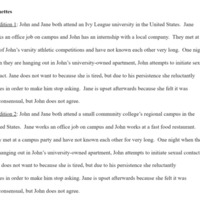Browse Exhibits (28 total)
Keldyn Young | Emotional Support Among College Students
This study examined the comparision of percieved emotional support from peer and familial figures among first-generation (N=15) and continuing-generation (N=41) college students. This study also examined the relationships between emotion regulation skills, self-efficacy, and academic achievement with overall preceived emotional support. First-generation college students reported significantly less emotional support from peer figures compared to continuing-generation college students. However, there was not a significant difference in emotional support from familial figures. In addition, there was a strong, postive correlation with overall perceived emotional support and emotion regulation skills for first-generation and continuing-generation college students.
Faculty Mentor: Anjolii Diaz
Psychological Science
Undergraduate
Ky Bray | Computerized Analysis of Linguistic Style Differences Between Offenders of Mass Shootings

Legacy tokens, artifacts written by offenders of mass shootings, provide a window through which violent behavior can be examined from the perspective of the offender. Many previous studies have investigated legacy tokens qualitatively, yet surprisingly few have conducted computerized text-analyses. Further, past work has yet to evaluate text-based differences between types of offenders, principally between those who commit suicide or survive a mass shooting event. The present study intends to use a quantitative approach to exploring these differences by using the closed-content, text analysis software, Linguistic Inquiry and Word Count (LIWC). To accomplish this, legacy tokens will be harvested from an online database, verified by at least one other internet source, and submitted to LIWC for analysis. Legacy tokens between offender types will be compared based on language style categories shown to indicate emotionality, cognitive complexity, and attention allocation.
Faculty Mentor: Thomas Holtgraves
Department of Psychological Science
Graduate
Lauren Szymczak | The relationships among dimensions of test anxiety and math exam performance

In a study of 117 undergraduate volunteers, the influence of activating test anxiety on decreasing performance in a standardized math test was evaluated. Using a pre-test and post-test design, students completed two versions of a standardized math exam. Between the two math tests, they completed a test anxiety battery, including the Reactions to Tests (RTT) Scale (Sarason, 1984) and the Cognitive Test Anxiety Scale-2 (CTAS-2) Scale (Thomas, Cassady, & Finch, 2017). Analysis looked at the relationships between test anxiety and performance (GPA and math items). Of particular interest was the influence of different levels of cognitive test anxiety on math performance, with a focus on differential performance rates based on item difficulty. The discussion section allowed a space to explain how different forms of test anxiety influence test performance in various ways.
Faculty Mentor: Dr. Jerrell Cassady
Department of Psychological Science
Undergraduate
Nicholas L. Mundell, Anna Harp, Audrey Hasser, Lauryn Jones, Mary Scott, Jon Sorgenfrei | Gender Differences in MMPI-2-RF Scale Scores in College Students
Internalizing disorders are characterized by several negative symptoms including stress, anxiety, and mood instability (Ben-Porath, 2012; Duffy et al., 2017). The literature suggests that more women than men are diagnosed with internalizing disorders like depression (Nolen-Hoeksema, 1994). One mechanism that has been supported as influencing this difference is gender stereotypes, which encourage women and men to express emotions differently (Rosenfield et al., 2000). One specific area within the internalizing spectrum where we may see these gender differences is anger proneness. Anger proneness (ANP) is the tendency to become easily angered, upset, or impatient with others (Ben-Porath, 2012). Indeed, there is evidence to suggest that men tend to express anger more externally whereas women tend to express anger more internally (Dawson et al., 2010).
Despite past research on gender differences in internalizing disorders, previous literature has not examined gender differences in specific scales like the MMPI-2-RF ANP scale. Thus, the current study examined whether gender differences exist on the MMPI-2-RF ANP scale. We hypothesized that men would score higher than women. To achieve this goal, we used an archival dataset of college students who scored higher than average on the MMPI-2-RF Emotional/Internalizing Dysfunction scale. The assumption of normality for an independent samples t-test was violated so, we conducted an independent samples Mann-Whitney U test. The independent samples Mann-Whitney U test indicated that women and men endorsed similar levels of anger proneness, p=.72.
The MMPI-2-RF ANP scale captures negative emotional experiences of anger, but not how individuals act on these emotions. So, gender differences in anger may be better captured by the MMPI-2-RF Aggression scale which measures aggressive behaviors in response to feelings of anger. It may be that women and men experience feelings of anger similarly, but act on these emotions differently. For example, one’s culture and adherence to stereotypes affects the extent to which they engage in stereotype-consistent behaviors (Eagly et al., 2019). Thus, we may have a sample who more loosely adheres to gender stereotypes and therefore engages in fewer stereotype-consistent behaviors. Future research should investigate the effect of stereotypes on anger-related behaviors when other characteristics are accounted for.
Faculty Mentor: Tayla T.C. Lee
Department of Psychological Science
Graduate
Pauline Robinson-Stevens | The Impact of Social Status on Attributions of Responsibility in Instances of Sexual Assault

The current research analyzed how a perpetrator’s achieved social status (ex: education level, occupation, accomplishments) influenced participants’ attributions of responsibility for an instance of sexual assault to either the perpetrator or the victim, as well as how observer gender impacted attitudes. I predicted that if an observer (i.e. a participant) was a stranger to both the perpetrator and the survivor, they would be more likely to assign responsibility for the assault to the survivor if the observer identified as male and if the perpetrator was of a higher social status.
Faculty mentor: Dr. Andrew Luttrell
Department of Psychological Science
Undergraduate
Honors College
Raven Hill | Becoming Knowledgeable About Wine and Plants: Measuring Readers’ Ability to Infer a Main Idea
The ability to draw generalized inferences is an important component of how readers conceptualize a text. Additionally, a variable such as instructional reading goal (i.e., study vs. entertainment) may change how readers are able to comprehend a text. The purpose of this pilot study will verify two created expository texts and determine whether the assigned reading goal changes readers’ ability to make generalized inferences. This experimental research design of N=280 in the Ball State Psychological Sciences subject pool will be given two expository texts that have been created to successfully let readers draw generalized inferences. Additionally, each participant will read each text with a randomly assigned reader goal (either study or entertainment). It is hypothesized that participants will be able to draw the intended generalization inference 75% of the time for each paragraph of each text. It is also hypothesized that the study goal will predict a higher amount of generalization inferences compared to the entertainment goal.
Faculty Mentors: Dr. Kristin Ritchey and Dr. Thomas Holtgraves
Psychological Science
Graduate
Sydney Ruggles | The Role of Dehumanization on Sexist and Violent Attitudes
The dehumanization theory has recently come into question as it has various definitions between the three fields in which it is studied (e.g., social psychology, neuroscience, philosophy) (Over, 2020). Past research has shown that the dehumanization of another person can lead to increased willingness to cause harm on said person (Rudman & Mescher, 2012; Viki et al., 2013). The present study seeks to gain more clarity into the psychological side of the dehumanization theory through the combination of several previous studies with different methods of achieving dehumanization (Rudman & Mescher, 2012; Tipler & Ruscher, 2019; Viki et al., 2013). While many previous studies have focused on harm, this study will be exploring sexist attitudes and attitudes towards violence. Adults over the age of 18 recruited from Facebook and Reddit will take a survey containing a dehumanization manipulation as well as questionnaires measuring levels of sexism and attitudes towards violence. Only half of the participants will actually be manipulated for dehumanization in this study. A Qualtrics survey will employ a dehumanization vignette, the Ambivalent Sexism Inventory (Glick & Fiske, 1996), and the Revised Attitudes Towards Violence Scale (Anderson et al., 2006). The relationship between those who are manipulated for dehumanization and those who are not will be examined through an independent samples t-test in SPSS. The outcomes of this research will ideally help with some of the disconnect that is present within the dehumanization theory while also providing information about previously under-researched areas.
Faculty Mentor: Dr. Thomas Holtgraves
Department of Psychological Science
Graduate
Travis Kelly | The Emotional Toll of a Pandemic: A Linguistic Analysis of Twitter Posts Throughout COVID-19
Little research has currently been done focusing on how the COVID-19 pandemic has affected the mental and emotional processes of people in the United States. The few studies that have been published so far have focused on self-report measures to analyze the impact (Son et al., 2020; Taylor et al., 2020). While these publications are a good first step, more research needs to be done using methods controlling for the bias often found in self-report data. As very research has been used with naturally occurring data, the present study focuses on this approach.
Faculty Mentor: Dr. Thomas Holtgraves
Psychological Science
Undergraduate
